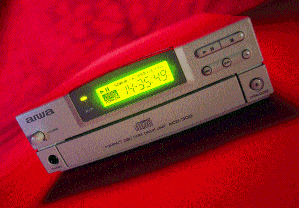
It might not be the fastest CD-ROM drive you'll ever meet, argues Nick Veitch, but it's almost certainly the sexiest.

It might not be the fastest CD-ROM drive you'll ever meet, argues Nick Veitch, but it's almost certainly the sexiest.

What can you do to make a CD-ROM drive stand out from the crowd these days? Apart from the speed factor, which seems to be an active area at the moment, one double-speed CD-drive is very much like another, is it not?
They virtually all have two phono outs for audio, self-terminating SCSI interfaces and an off-white case. So what makes the Aiwa ACD300 any different from the Apple CD300? Just about everything, it turns out.
The most obvious difference is the front panel, where the ACD300 boasts a large back-lit LCD display, set prominently at the top of a taller-than-average case.
The information on the display varies. Normally it displays the SCSI ID number, which probably isn't important to many people - most simply set up their software once and forget about it - but for Amiga users who are always trying out new CD utilities (PhotoCD players, audio CD juke boxes) it could be useful. It's certainly better than not displaying anything. There is also an indicator to display whether the internal SCSI termination is active or not - again, occasionally useful for a few.
Load a disc and you will automatically be told whether it is an audio or CD-ROM disc, or, indeed, both. PhotoCDs will display session data, which is very useful - since only 25 sessions are allowed, you can check to see how many times you can add to your PhotoCD - while audio CDs will automatically display the number of tracks and total running time.
It's easy to play audio CDs on this drive because it has standard audio buttons (play/pause, stop, skip, etc) on the front. There is even a repeat button, which can auto-repeat a single track or the whole CD, or can activate the unit's `shuffle' mode. This is certainly easier than fiddling around with CD control software on your Amiga, no matter how wonderful that software may be.
A headphone jack and volume knob are on the front of the unit, but oddly the power switch is on the side - which, as it happens, is more convenient for my set-up, but for most people would probably be less useful than a switch on the back.
Around the rear of the unit are twin phono outs, twin SCSI connectors, the SCSI ID selector and a DIP switch. The Dip can be used to turn auto-termination on or off, select standard or double-speed modes and turn parity checking on or off.
The mechanism uses a tray loading system, so you don't have to mess about with ridiculous caddies, and the tray will also accept the smaller-sized audio discs. In the unlikely event of a tray jam there is a release screw on the underside of the case, and the drive even comes with a screwdriver for this purpose.
In operation the drive seems efficient and smooth. Stable transfer rates probably owe a lot to the memory used in the on-board 256k buffer, which makes animation playback straight from CD very impressive. The drive does emit a rather unusual whirring noise when the head is seeking, and although it is a little odd, it's not actually louder than any other drive - it's just a rather peculiar noise.
The device has a standard double-speed 300k/sec transfer rate, is SCSI-2 compliant, multi-session, and is in every practical sense totally ordinary. But with its ease of use, pose value and nice buttons to press, this unit is streets ahead.
DISTRIBUTOR: First Comp Centre 01132 319444
PRICE: £169.99 (or £209.99 with Squirrel interface)
SYSTEM REQUIREMENTS: SCSI interface.SPEED:
Standard for a double-speed drive, although you can't help thinking transfers are somehow smoother.
MANUAL:
Multilingual, but diagrams are good and it explains every feature.
ACCESSIBILITY:
The audio controls are so useful, and the LCD display could be more than just a gimmick for some.
FEATURES:
It is hard to think of any feature it lacks. Perhaps an attachment for taking stones out of horses' hooves?
VALUE:
You could probably buy an equally useful drive for around £40 less - but there are plenty of less exciting drives around at the same price.
"A vast wealth of features in a stylish case. I know where my birthday money is going."